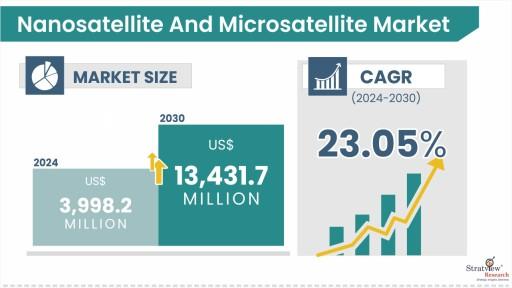The Growth of Nanosatellites and Microsatellites: Opportunities and Drivers

The Nanosatellite and Microsatellite market is witnessing an unprecedented growth trajectory, driven by advancements in space technology, lower launch costs, and increasing demand for data-driven services in various industries. These small satellites, typically weighing less than 100 kg, are enabling new possibilities in communications, Earth observation, scientific research, and more.
The global nanosatellite and microsatellite market is expected to grow from USD 3,998.2 million in 2024 to USD 13,431.7 million by 2030, at a healthy CAGR of 23.05% during 2024-2030.
Market Drivers:
-
Cost-Effective Space Access: One of the key drivers is the significant reduction in the cost of satellite launches. With companies like SpaceX lowering the price of sending payloads into space, small satellites can now be deployed at a fraction of the cost compared to traditional satellites. This has opened the doors for new players to enter the space industry.
-
Technological Advancements: Improvements in miniaturization, lightweight components, and propulsion systems have made small satellites more capable, allowing them to perform a wider range of tasks. For example, advancements in on-board imaging systems, sensors, and communication technology enable Nanosatellites and Microsatellites to perform Earth observation with a high degree of accuracy.
-
Demand for Data Services: Nanosatellites and Microsatellites are being used extensively for Earth monitoring, offering services in agriculture, climate research, disaster management, and infrastructure monitoring. These small satellites are crucial for providing real-time data, supporting decision-making across multiple sectors.
Challenges:
-
Orbital Debris Management: With the proliferation of small satellites, there are growing concerns about space debris. Governments and space agencies are focusing on implementing policies to manage and reduce orbital debris, which is a potential risk for both current and future satellite missions.
-
Limited Lifespan: The limited operational lifespan of small satellites, typically ranging from 5 to 7 years, can pose a challenge for long-term data continuity and reliability. While advancements are being made to extend the lifespan, this remains a critical consideration for satellite operators.
Opportunities:
-
New Market Applications: The expansion of the Internet of Things (IoT), global communications, and remote sensing applications opens up new market opportunities for small satellites. Particularly, applications in disaster management, communications in remote areas, and surveillance are expected to see strong growth.
-
Space as a Service: The emerging trend of “Space as a Service” is allowing non-space companies to leverage satellite technology for specific missions without the need to own and operate the satellites. This trend is expected to boost demand in the commercial sector.
To get free sample, Click Here: https://www.stratviewresearch.com/Request-Sample/4139/nanosatellite-and-microsatellite-market.html#form
Conclusion:
The Nanosatellite and Microsatellite market is poised for rapid expansion, driven by technological innovation, cost reductions, and increasing demand for real-time data. With continued advancements in satellite technology and regulatory frameworks to address emerging challenges, the market offers significant growth opportunities across a range of sectors.
- Information Technology
- Office Equipment and Supplies
- Cars and Trucks
- Persons
- Books and Authors
- Tutorials
- Art
- Causes
- Crafts
- Dance
- Drinks
- Film
- Fitness
- Food
- Spellen
- Gardening
- Health
- Home
- Literature
- Music
- Networking
- Other
- Party
- Religion
- Shopping
- Sports
- Theater
- Wellness



